Albedo gardens enhance climate resilience by incorporating high-reflectivity plants that reduce heat absorption and lower local temperatures. The strategic use of light-colored foliage and surfaces increases solar reflectance, mitigating urban heat island effects and conserving water. This innovative planting method supports sustainable ecosystems while promoting energy efficiency in residential and public spaces.
Understanding Albedo in Garden Design
Albedo in garden design refers to the reflectivity of surfaces, influencing microclimates and temperature regulation within planting areas. High-albedo plants and materials reflect more sunlight, reducing heat absorption and mitigating heat stress on vegetation during extreme weather. Incorporating albedo principles enhances climate resilience by optimizing energy balance and supporting plant health in changing environments.
The Role of Reflective Surfaces in Climate-Resilient Landscaping
Reflective surfaces in albedo gardens play a crucial role in climate-resilient landscaping by reducing heat absorption and mitigating urban heat island effects. High-albedo materials, such as light-colored gravel, reflective mulches, and pale stone, increase surface reflectivity, lowering ambient temperatures and conserving soil moisture. Integrating these surfaces enhances plant survival during heatwaves and reduces irrigation demands, contributing to sustainable, climate-adaptive garden design.
How Albedo Gardens Mitigate Urban Heat
Albedo gardens reduce urban heat by increasing surface reflectivity, using light-colored plants and materials that reflect more solar radiation. This higher albedo effect minimizes heat absorption, lowering surrounding temperatures and mitigating the urban heat island phenomenon. Implementing albedo gardens in cities enhances microclimate regulation and supports sustainable, climate-resilient urban landscapes.
Key Principles for Designing Albedo Gardens
Albedo gardens prioritize surface reflectivity by incorporating light-colored materials and plants with high reflectance to reduce heat absorption and mitigate urban heat islands. Key principles include selecting vegetation with varying albedo values for seasonal effectiveness, optimizing plant placement for maximal sunlight reflection, and integrating permeable surfaces to enhance soil moisture retention. Designing with a focus on albedo balance promotes temperature regulation and supports climate resilience in urban landscapes.
Selecting High-Albedo Plants for Resilience
Selecting high-albedo plants for an Albedo garden enhances climate resilience by reflecting more solar radiation, thereby reducing heat absorption and mitigating urban heat island effects. Species like white-flowering shrubs, silver-leafed perennials, and light-colored succulents optimize surface reflectivity while conserving water and supporting biodiversity. Incorporating these plants strategically in landscape design improves thermal comfort and promotes sustainable ecosystem services.
Integrating Hardscape with Albedo Strategies
Integrating hardscape elements with albedo strategies in a climate-resilient Albedo garden enhances surface reflectivity, reducing heat absorption and mitigating urban heat island effects. Using light-colored materials such as white gravel, concrete, and reflective pavers increases solar reflectance, promoting cooler microclimates and conserving water by minimizing evapotranspiration. This approach supports sustainable landscaping by balancing aesthetics with environmental functionality, optimizing energy efficiency and resilience to climate change.
Water Management in Reflective Gardens
Albedo gardens utilize high-reflectance surfaces to reduce soil temperatures and evaporation rates, enhancing water retention in arid environments. By incorporating drought-tolerant plants and reflective mulches, these gardens optimize water efficiency and minimize irrigation needs. Innovative water management techniques in albedo gardens contribute significantly to urban climate resilience by conserving water and mitigating heat stress.
Biodiversity Benefits of Albedo Planting
Albedo gardening enhances biodiversity by selecting plants with varied reflectivity levels, creating microhabitats that support diverse insect and bird populations. By increasing surface albedo, these gardens reduce local temperatures, promoting resilience against climate stressors and fostering healthier ecosystems. The strategic diversity in albedo planting improves soil health and water retention, further sustaining native flora and fauna.
Maintenance Tips for Climate-Resilient Albedo Gardens
Climate-resilient Albedo gardens require minimal watering due to their reflective surfaces reducing soil temperature and moisture loss. Regular pruning of heat-tolerant species supports healthy growth and maximizes albedo effectiveness by maintaining reflective leaf surfaces. Implementing mulching with light-colored materials further enhances moisture retention and temperature regulation in these gardens.
Case Studies: Successful Albedo Gardens Around the World
Albedo gardens strategically use high-reflectance plants and materials to reduce urban heat and improve microclimates, as demonstrated in case studies from Phoenix, Arizona, and Melbourne, Australia. These gardens showcase how increased surface reflectivity can lower local temperatures by up to 3degC, enhancing climate resilience in arid and temperate regions. Data from these projects confirm significant energy savings by reducing cooling demands in adjacent buildings, setting a replicable model for sustainable urban landscaping.
Albedo garden Infographic

 gardenot.com
gardenot.com